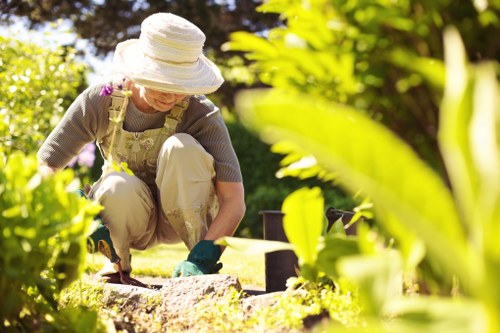Mastering Hedge Trimming in Poplar: A Comprehensive Guide

Introduction to Hedge Trimming in Poplar
Poplar hedges are a popular choice for homeowners and landscapers alike due to their rapid growth and lush foliage. Proper hedge trimming not only enhances the aesthetic appeal of your property but also promotes the health and longevity of the trees. In this guide, we will delve into the essentials of trimming poplar hedges, ensuring they remain beautiful and well-maintained throughout the seasons.
Understanding the unique characteristics of poplar trees is crucial for effective trimming. Poplars are known for their tall stature and flexible branches, which can be shaped with the right techniques. Whether you're a seasoned gardener or a novice, mastering hedge trimming in poplar can transform your landscape.
Before you begin, it's important to gather the necessary tools and familiarize yourself with the best practices. This ensures that the trimming process is efficient and minimizes any potential damage to the trees.

Essential Tools for Trimming Poplar Hedges
Having the right tools at your disposal makes a significant difference in the quality of your hedge trimming. Here's a list of must-have tools for trimming poplar hedges:
- Pruning Shears: Ideal for precise cuts and shaping smaller branches.
- Hedge Trimmers: Electric or gas-powered trimmers are perfect for cutting through thicker branches and maintaining uniformity.
- Loppers: These provide the necessary leverage to cut through larger branches that pruners can't handle.
- Gloves and Safety Gear: Protect your hands and eyes from debris and sharp branches.
- Sturdy Ladder: For reaching higher sections of the hedge safely.
Investing in high-quality tools not only makes the trimming process easier but also ensures cleaner cuts, which are essential for the health of your poplar hedge.
Regular maintenance of these tools will extend their lifespan and maintain their effectiveness. Clean and sharpen your tools after each use to prevent the spread of diseases and ensure smooth operation.

Timing Your Hedge Trimming for Optimal Growth
Timing is everything when it comes to hedge trimming. For poplar trees, the best time to trim is during the late winter or early spring before new growth begins. This period allows the trees to recover quickly and encourages robust growth in the warmer months.
Trimming during the dormant season reduces stress on the trees and minimizes the risk of infections. Additionally, avoiding trimming during extreme weather conditions, such as drought or frost, helps maintain the health of your hedge.
It's also important to consider the growth patterns of poplar trees. Regular trimming throughout the growing season can help control the size and shape of the hedge, preventing it from becoming overgrown and unruly.

Step-by-Step Guide to Trimming Poplar Hedges
1. Assess the Hedge
Begin by evaluating the current state of your poplar hedge. Look for any dead or diseased branches that need to be removed. Assess the overall shape and decide on the desired height and width of the hedge.
2. Plan Your Cuts
Identify the branches that need to be trimmed to achieve the desired shape. It's essential to make clean, precise cuts to promote healthy regrowth.
3. Start Trimming
Using your pruning shears or hedge trimmers, begin trimming from the bottom up. This approach ensures that the lower branches receive adequate sunlight and air circulation.
Maintaining Symmetry
Ensure that both sides of the hedge are evenly trimmed. Use a string line or a straight edge as a guide to maintain symmetry and achieve a professional look.
Final Touches
After the main trimming, go over the hedge to fine-tune any uneven areas. This step ensures a uniform appearance and enhances the overall aesthetics of your poplar hedge.

Aftercare and Maintenance Tips
Proper aftercare is essential to maintain the health and beauty of your trimmed poplar hedge. Follow these tips to ensure your hedge remains in top condition:
- Watering: Ensure the hedge receives adequate water, especially during dry spells. Deep watering encourages strong root growth.
- Fertilizing: Use a balanced fertilizer in the spring to promote healthy growth and vibrant foliage.
- Pest Control: Monitor your hedge for signs of pests or diseases and treat them promptly to prevent spread.
- Regular Inspection: Periodically check the hedge for any signs of damage or overgrowth, and address issues promptly.
- Seasonal Trimming: Depending on the growth rate, consider light trimming in the summer to maintain shape and size.
Consistent maintenance not only keeps your poplar hedge looking its best but also extends its lifespan, ensuring it continues to provide privacy and beauty to your landscape for years to come.
Implementing these aftercare practices will help your trimmed poplar hedge thrive, maintaining its lush appearance and structural integrity.
Common Mistakes to Avoid
While trimming poplar hedges, it's easy to make mistakes that can affect the health and appearance of the trees. Here are some common pitfalls to avoid:
- Over-Trimming: Removing too much foliage at once can stress the tree and impede its growth.
- Improper Cutting Techniques: Making jagged or uneven cuts can lead to disease and hinder the healing process.
- Ignoring Safety: Neglecting to use protective gear increases the risk of injury while trimming.
- Trimming at the Wrong Time: Cutting during the growing season can disrupt the tree's natural growth cycle.
- Using Dull Tools: Dull blades can cause tearing instead of clean cuts, damaging the branches.
Awareness of these common mistakes and taking steps to avoid them will ensure your poplar hedge remains healthy, attractive, and a standout feature of your landscape.
By following best practices and being mindful of these potential errors, you can achieve professional-looking results and maintain the vitality of your poplar hedges.
Hiring a Professional vs. DIY Trimming
Deciding whether to trim your poplar hedge yourself or hire a professional depends on several factors, including the size of the hedge, your skill level, and the tools you have available.
Benefits of Hiring a Professional
Professionals bring expertise and experience to the task, ensuring precise and efficient trimming. They have access to specialized tools and can handle large or complex hedges with ease. Additionally, hiring a professional saves you time and reduces the risk of injury associated with using heavy equipment.
Advantages of DIY Trimming
Trimming your hedge yourself can be cost-effective and allows you to maintain a personal touch in your garden. It's a rewarding activity that gives you complete control over the shaping and care of your poplar hedge. With the right tools and knowledge, DIY trimming can be a manageable and satisfying task.
Making the Right Choice
Consider the size and complexity of your hedge, your available time, and your comfort level with using trimming tools when deciding between hiring a professional and doing it yourself. Sometimes, a hybrid approach—handling regular maintenance yourself and hiring professionals for more extensive work—can offer the best of both worlds.
Ultimately, whether you choose to trim your poplar hedge yourself or enlist professional help, ensuring that the task is done correctly will result in a beautiful and healthy hedge that enhances your property's appeal.
Enhancing Your Poplar Hedge with Complementary Plants
To create a stunning landscape, consider complementing your trimmed poplar hedge with a variety of plants. The right combination can add color, texture, and depth to your garden, making it more inviting and visually appealing.
Choosing the Right Plants
Select plants that thrive in similar conditions as poplar trees, such as full sun to partial shade and well-drained soil. Consider adding flowering shrubs, perennials, or ground covers to enhance the visual interest.
Arranging for Maximum Impact
Strategically place complementary plants to balance the height and form of your poplar hedge. Mixing different textures and colors can create a harmonious and dynamic garden space.
Seasonal Considerations
Incorporate plants that bloom at different times of the year to ensure your garden remains vibrant throughout all seasons. This approach provides continuous interest and complements the evergreen nature of poplar hedges.
By thoughtfully selecting and arranging complementary plants, you can create a cohesive and attractive landscape that highlights the beauty of your trimmed poplar hedge.
Environmental Benefits of Poplar Hedges
Poplar hedges offer numerous environmental benefits that go beyond their aesthetic appeal. Understanding these advantages can help you appreciate the value of maintaining healthy, well-trimmed hedges.
- Air Quality Improvement: Poplar trees are effective at filtering pollutants and releasing oxygen, contributing to cleaner air.
- Privacy and Shelter: Thick poplar hedges provide privacy and act as windbreaks, creating a more comfortable outdoor environment.
- Erosion Control: The robust root systems of poplar trees help stabilize the soil, preventing erosion.
- Wildlife Habitat: These hedges offer shelter and food for various bird species and other wildlife, promoting biodiversity.
- Noise Reduction: Dense poplar hedges can absorb and reduce ambient noise, creating a quieter and more serene setting.
By investing time and effort into proper hedge trimming, you not only enhance the beauty of your property but also contribute positively to the surrounding environment.
These environmental benefits make poplar hedges a valuable addition to any landscape, providing both functional and aesthetic advantages.
Sustainable Practices in Hedge Trimming
Adopting sustainable practices in hedge trimming ensures that your gardening efforts are environmentally friendly and contribute to the long-term health of your landscape.
Using Eco-Friendly Tools
Opt for manual or battery-powered tools instead of gas-powered ones to reduce emissions and minimize your carbon footprint. Regularly maintain your tools to ensure they operate efficiently and last longer.
Composting Trimmings
Instead of disposing of hedge trimmings, compost them to create nutrient-rich soil that can be reused in your garden. This practice reduces waste and supports sustainable gardening.
Water Conservation
Implement water-saving techniques, such as mulching and using drip irrigation, to ensure your poplar hedge receives adequate moisture without overusing water resources.
By integrating these sustainable practices into your hedge trimming routine, you contribute to a healthier environment and promote the longevity of your poplar hedges.
Embracing sustainability in your gardening activities not only benefits your immediate surroundings but also supports broader environmental conservation efforts.
Conclusion: Achieving the Perfect Poplar Hedge
Trimming poplar hedges is both an art and a science. With the right tools, techniques, and timing, you can maintain a healthy, attractive hedge that enhances your property's beauty and provides numerous environmental benefits.
Remember to assess your hedge regularly, use proper trimming methods, and adopt sustainable practices to ensure your poplar hedge remains a standout feature of your landscape. Whether you choose to handle the trimming yourself or hire a professional, the effort invested will result in a vibrant and thriving hedge for years to come.
Ready to transform your garden with expertly trimmed poplar hedges? Contact us today to schedule your hedge trimming service and experience the difference professional care can make.

